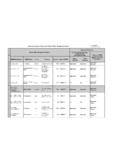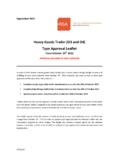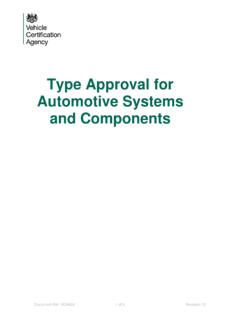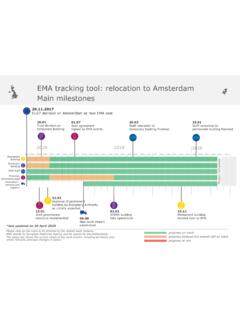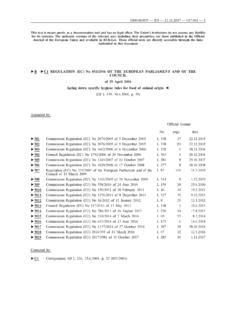Transcription of Standard application format and guidance document for …
1 Freiburg, 30 August 2012 ko-Institut Freiburg Head Office Box 17 71 79017 Freiburg, Germany Street Address Merzhauser Str. 173 79100 Freiburg Tel. +49 (0) 761 4 52 95-0 Fax +49 (0) 761 4 52 95-288 Darmstadt Office Rheinstr. 95 64295 Darmstadt, Germany Tel. +49 (0) 6151 81 91-0 Fax +49 (0) 6151 81 91-133 Berlin Office Schicklerstr. 5-7 10179 Berlin, Germany Tel. +49 (0) 30 40 50 85-0 Fax +49 (0) 30 40 50 85-388 Final Standard application format and guidance document for RoHS exemption requests on the basis of Article 5(8) Directive 2011/65/EU Authors: Dr. Otmar Deubzer Carl-Otto Gensch St phanie Zangl Katja Moch Yifaat Baron guidance document RoHS 2 exemptions evaluation guidance document RoHS 2 exemptions evaluation IV Table of contents For whom this document is intended 1 Do RoHS exemptions concern me?
2 1 Criteria for Exemptions 3 How and do I apply for an exemption? 7 What happens once I apply for an exemption? 8 Everything you need to know about timelines for exemptions 9 application format and elaboration of necessary documentation for submitting an exemption request 11 Further Resources 11 Attachment: application Form 12 guidance document RoHS 2 exemptions 1 1 Annex: Standard application format and guidance document for RoHS exemption requests on the basis of Article 5(8) Directive 2011/65/EU For whom this document is intended This document is intended for economic operators of establishments responsible for putting electrical and electronic equipment on the European market, as well as establishments active in the development of materials and applications that may be used as part of such equipment.
3 Economic operators may include: Manufacturers of electrical and electronic equipment and parts thereof Representatives authorized to act on behalf of manufacturers Distributors of electrical and electronic equipment Importers of electrical and electronic equipment Do RoHS exemptions concern me? The 2011/65/EU Directive1 (henceforth RoHS 2) restricts the use of certain hazardous substances in electrical and electronic equipment placed on the European market. If an article falls under the scope of equipment given in the RoHS 2 directive, it should be regulated accordingly, thus ensuring that it does not include one of the restricted substances above a prescribed amount. The regulated substances are listed in Annex 2 of the Directive as well as the maximum tolerated amount of the substance permitted in any homogenous material from which the application is comprised.
4 At present the list of substances and tolerated values includes: Lead (Pb), ( ) Mercury (Hg), ( ) Cadmium (Cd), ( ) Hexavalent chromium (chromium VI, Cr+6), ( ) Polybrominated biphenyls (PBB), ( ) Polybrominated diphenyl ethers (PBDE), ( ) You should be aware that legislation may provide for adjustments of the list of substances and/or tolerated amounts from time to time, in correspondence with available scientific and technological developments. 1 Directive 2002/95/EC on the Restriction of Hazardous Substances came into force in January 2003 and was known as the RoHS directive. A recent recast in the form of Directive 2011/65/EU has brought into force the RoHS 2 regime, to which this document refers if not explicitly stating otherwise.
5 guidance document RoHS 2 exemptions evaluation 2 Homogeneous material means a material that cannot be mechanically disjointed or separated into different materials, by use of actions such as unscrewing, cutting, crushing, grinding and abrasive processes. A few examples2 are listed below: A plastic cover is a "homogeneous material" if it consists of one type of plastic that is not coated with or has attached to it or inside it any other kinds of materials. In this case the limit values of the directive would apply to the plastic. An electric cable that consists of metal wires surrounded by non-metallic insulation materials is an example of a "non-homogeneous material" because the different materials could be separated by mechanical processes.
6 In this case the limit values of the directive would apply to each of the separated materials individually. A semi-conductor package contains many homogeneous materials which include: plastic moulding material, tin-electroplating coatings on the lead frame, the lead frame alloy and gold-bonding wires. Anyone who is involved with the production of such an article, be it for purposes of putting such equipment onto the market, for research activities concerning substitutes or for (legal) services around these issues, should be aware of the RoHS Directive. In most cases, it will be companies that want to have legal certainty for their products that will need to check whether an existing exemption either applies or whether a new or amended one should be pursued.
7 Also, some companies or research institutions might be involved in developing substitutes and would hence like to increase the incentives for them to be used, which is why they may like to apply for the deletion of an exemption. If you would like to check whether your application falls under the RoHS 2 scope, you may find some guidance within the Frequently Asked Questions (FAQ) draft from 15 June, 2012 mentioned in section of this document . Further questions may be referred to the European Commission by e-mail or post or to the national authorities. A list of national authorities can be found here: If you have found your application to be under the scope of RoHS 2, you may want to check if the criteria for exemption are applicable, to see if you have grounds for submitting a request for exemption.
8 This should also be done if an exemption already exists but requires renewal or change of wording to cover additional similar applications , as well as in cases 2 Examples are cited from: European Commission Directorate General Environment, 2006, Frequently Asked Questions document on Directive 2002/95/EC on the Restriction of the Use of certain Hazardous Substances in Electrical and Electronic Equipment (RoHS) and Directive 2002/96/EC on Waste Electrical and Electronic Equipment (WEEE) , cf. under guidance document RoHS 2 exemptions 3 where you would like to apply for the revoke of an exemption, due to recent scientific or technical developments.
9 Criteria for Exemptions The directive3 includes a few criteria according to which RoHS 2 exemptions can be justified. This means that under specific circumstances, temporary permission, for placing EEE, which contains the RoHS 2 banned substances, on the EU market, may be granted. Such exemptions are then listed under Annexes III and IV of the directive. The following excerpt demonstrates how exemptions are listed in the directive annexes: Table 1: Excerpt of Directive 2011/65/EU (RoHS 2) Annex III Exemption Scope and dates of applicability 33 Lead in solders for the soldering of thin copper wires of 100 m diameter and less in power transformers 34 Lead in cermet-based trimmer potentiometer elements 36 Mercury used as a cathode sputtering inhibitor in DC plasma displays with a content up to 30 mg per display Expired on 1 July 2010 37 Lead in the plating layer of high voltage diodes on the basis of a zinc borate glass body 38 Cadmium and cadmium oxide in thick film pastes used on aluminium bonded beryllium oxide 39 Cadmium in colour converting II-VI LEDs (< 10 g Cd per mm of light-emitting area)
10 For use in solid state illumination or display systems Expires on 1 July 2014 It should be noted that the criteria mentioned in the directive do not automatically justify an exemption but may rather be understood as the framework for your argumentation towards exemption justification. Assuming it can be shown that some of the criteria apply towards a certain application , the European Commission will still have the right of discretion in deciding if and under what circumstances the exemption should be granted. One should also not assume that any single criteria can be seen as a minimum threshold that an exemption request must reach, but rather that respective argumentation towards the various points will be weighed and considered during the decision process.










